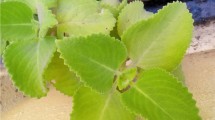Abstract
The present study reports biologically oriented process for green synthesis of CuO nanoparticles by using eco-friendly and non-toxic Aloe vera leaf extract. Powder X-ray diffraction and transmission electron microscope analysis revealed that synthesized CuO nanoparticles are in monoclinic phase with average particle size of 20 nm. The antibacterial activity of green synthesized CuO nanoparticles was tested against three bacterial fish pathogens “viz:” Aeromonas hydrophila, Pseudomonas fluorescens and Flavobacterium branchiophilum, which are responsible for causing severe infectious diseases in fishes. CuO NPs exhibits enhanced antibacterial activity against all the fish pathogens even at lower concentrations, i.e. above 20 μg/mL.





Similar content being viewed by others
References
Nalwa, H. S. (2000). Handbook of nanostructured materials and nanotechnology. New York: Academic.
Alivisatos, A. P. (1996). Semiconductor clusters, nanocrystals, and quantum dots. Science, 271, 933–937.
Siavash, I. (2011). Green synthesis of metal nanoparticles using plants. Green Chemistry, 13, 2638–2650.
Das, S. K., Khan, M. M. R., Guha, A. K., Das, A. R., Mandal, A. B. (2012). Silver-nano biohybride material: synthesis, characterization and application in water purification. Bioresource Technology, 124, 495–499.
Das, S. K., Dickinson, C., Lafir, F., Brougham, D. F., Marsili, E. (2012). Synthesis, characterization and catalytic activity of gold nanoparticles biosynthesized with Rhizopus oryzae protein extract. Green Chemistry, 14, 1322–1334.
Das, S. K., Khan, M. M. R., Guhab, A. K., Naskar, N. (2013). Bio-inspired fabrication of silver nanoparticles on nanostructured silica: characterization and application as a highly efficient hydrogenation catalyst. Green Chemistry, 15, 2548–2557.
Rao, C. N. R. (1989). Transition metal oxides. Annual Review of Physical Chemistry, 40, 291–326.
Wang, Z. L. (2004). Functional oxides nanobelts—materials, properties and potential applications in nano systems and biotechnology. Annual Review of Physical Chemistry, 55, 159–196.
Rakhshani, A. E. (1986). Preparation, characteristics and photovoltaic properties of cuprous oxide—a review. Solid State Electronics, 29(1), 7–17.
Premkumar, T., & Geckeler, K. E. (2006). Nanosized CuO particles via a supramolecular strategy. Small, 2(5), 616–620.
Ren, G., Hu, D., Cheng, E. W., Vargas-Reus, M. A., Reip, P., Allaker, R. P. (2009). Characterization of copper oxide nano particles for antimicrobial applications. International Journal of Antimicrobial Agents, 33(6), 587–590.
Zailei, Z., Hongwei, C., Yingli, W., Lianying, S., Ziyi, Z., Fabing, S. (2012). Preparation of hierarchical dandelion-like CuO microspheres with enhanced catalytic performance for dimethyldichlorosilane synthesis. Catalysis Science and Technology, 2, 1953–1960.
Sangeetha, G., Rajeshwari, S., Venckatesh, R. (2012). Aloe barbadensis Miller mediated green synthesis of mono-disperse copper oxide nanoparticles: optical properties. Spectrochimica Acta Part A: Molecular and Biomolecular Spectroscopy, 97, 1140–1144.
Maensiri, S., Laokul, P., Klinkaewnarong, J., Phokha, S., Promarak, V., Seraphin, S. (2008). Indium oxide (In2O3) nanoparticles using Aloe vera plant extract: synthesis and optical properties. Journal of Optoelectronics and Advanced Materials, 10, 161–165.
Surjushe, A., Vasani, R., Saple, D. G. (2008). Aloe vera. Indian Journal of Dermatology, 53, 163–166.
Vijay Kumar, P. P. N., Pammi, S. V. N., Kollu, P., Satyanarayana, K. V. V., Shameem, U. (2014). Green synthesis and characterization of silver nanoparticles using Boerhaavia diffusa plant extract and their anti bacterial activity. Industrial Crops and Products, 52, 562–566.
Cappuccinno, J. G., & Sherman, N. (1999). Micro—a laboratory manual (pp. 254–256). Addison: Wesley Longman Inc.
Stohs, S. J., & Bagchi, D. (1995). Oxidative mechanisms in the toxicity of metal ions. Free Radical Biology and Medicine, 18(2), 321–336.
Acknowledgments
We are thankful to the DST-PURSE Programme, Advanced Analytical Laboratory, Andhra University, for the financial assistance and for their support in carrying out the research work regarding SEM-EDX and XRD analysis. The authors are thankful to CRNTS, IIT Bombay for the TEM characterization.
Author information
Authors and Affiliations
Corresponding author
Rights and permissions
About this article
Cite this article
Kumar, P.P.N.V., Shameem, U., Kollu, P. et al. Green Synthesis of Copper Oxide Nanoparticles Using Aloe vera Leaf Extract and Its Antibacterial Activity Against Fish Bacterial Pathogens. BioNanoSci. 5, 135–139 (2015). https://doi.org/10.1007/s12668-015-0171-z
Published:
Issue Date:
DOI: https://doi.org/10.1007/s12668-015-0171-z




